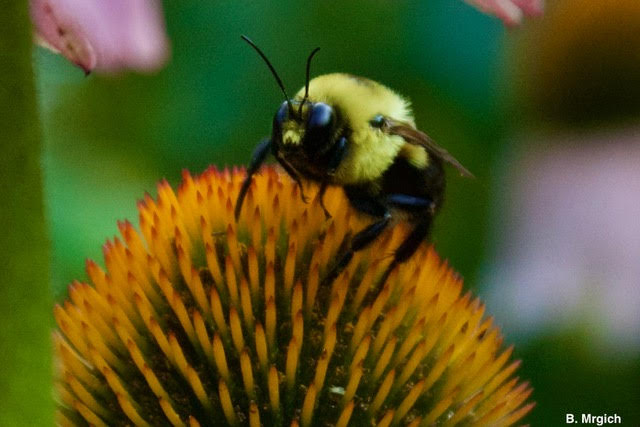 (4/5) The term "Coneflower" can sometimes be a confusing term especially to new gardeners. Most people think of the purple coneflower, or more appropriately, Echinacea, when they hear the term, but "Coneflower" can also be a Black-eyed Susan or some other Rudbeckia. Rudbeckia and Echinacea are related plants (in the same family), but definitely not the same plant.
(4/5) The term "Coneflower" can sometimes be a confusing term especially to new gardeners. Most people think of the purple coneflower, or more appropriately, Echinacea, when they hear the term, but "Coneflower" can also be a Black-eyed Susan or some other Rudbeckia. Rudbeckia and Echinacea are related plants (in the same family), but definitely not the same plant.
A garden club member sent me a photo of the tag for her new coneflower. What a beautiful color it is! The tag calls it Kismet Intense Orange.
In my opinion, this type of tag is very confusing. I have a very good friend who is new to gardening, and she will sometimes call to tell about this beautiful new plant that she just bought. When I ask, "What is it?", her answer might be Kismet Intense Orange. Well, that tells me nothing. If she said Echinacea, now I would know what she is talking about. But, if you look closely at the tag, you will notice that the word Echinacea is writ-ten in very tiny print. The next biggest word is Coneflower.
Coneflower is a common name for a plant that has a cone shaped seed head. Hence, the common name purple coneflower which refers to the native Echinacea.
All this supports my argument for using botanical names for plants instead of common names. Black-eyed Susans are actually Rudbeckia. A completely different plant from Echinacea. The original species of each is a native plant to the USA, and both are very beautiful in the garden. Both are called coneflowers.
Speaking of common names, a few years ago, I was on a garden tour where they gave away a free plant. I picked a small plant "Green-eyed Cone" strictly because I had no idea of what it was. Well, I brought it home and did a little research and found out it was Rudbeckia ‘laciniata,' a very tall Rudbeckia which has a green center instead of the more familiar black or brown. It is also a native of Adams County. I was thrilled with my new possession!
"Coneflowers" are probably one of the best known native plants, and the first thing that comes to most of our minds when asked to name a native plant. They are beautiful and loved, not only by us gardeners, but also by bees, butterflies and other pollinators. Did you know that Echinacea is not native to our area? It is native to the plains states - Illinois, Kansas, Iowa, etc.
Does this mean you shouldn’t include them in your native plant gardens? Absolutely not! What it tells you is a little about where they like to grow — full hot sun, with dry, well drained soil. They don’t like wet feet. Plant them in a soggy area with too much clay, and they will die quickly. Most of us in Adams County are blessed with a high clay content in our soil. If you have had trouble with coneflowers dying or becoming diseased, try moving them to a dryer spot. Also, adding compost to the soil regularly over the years will improve drainage considerably.
When I first started to garden, "purple" coneflowers were the only color available. Then, ten or more years ago, plant breeders started offering new colors. This was accomplished through hybridization, or you might say, selective breeding.
By now, they are available in many colors including deep pink, yellow, white, coral and orange. They are beautiful when mixed together or with Rudbeckia or Shasta Daisies - or just about anything for that matter.
All coneflowers can be deadheaded during the summer to help prolong bloom time, but towards the end of the season, stop deadheading and allow the seed heads to dry on the plant. Those seeds are an essential food source for songbirds during the winter, especially gold finches and cardinals.
Also, with your original purple coneflower, leaving the seed heads to dry will allow the plant to produce seedlings and your clump will expand producing even a better display next year. As for the newer colors, these are hybrids. The original plant (the one you bought) will return next year exactly like it looked this year, but it may be shorter-lived than the species. The seedlings of the hybrid, however, could be quite different in color, or revert to the purple.
One other word of caution with hybrids. Pollinators may not be as attracted to the hybrid as they are to the straight species, depending on whether they recognize it or not. If you are supporting the pollinators, stay way from the "doubles" and "pom poms". Double-flowered blooms are of little value to pollinators because the flower structures have mutated to a point where the pollen and nectar are reduced or no longer even exist.